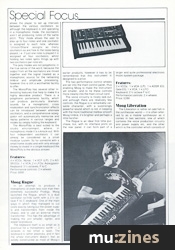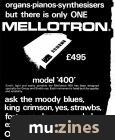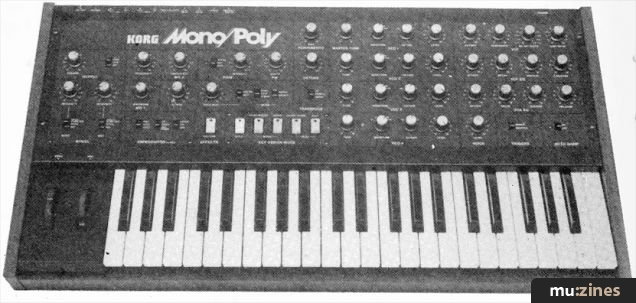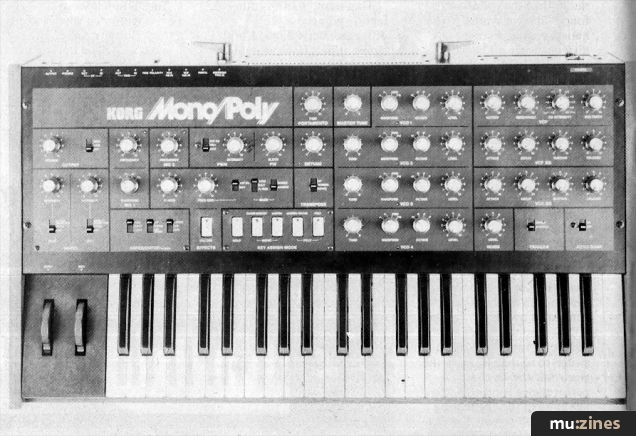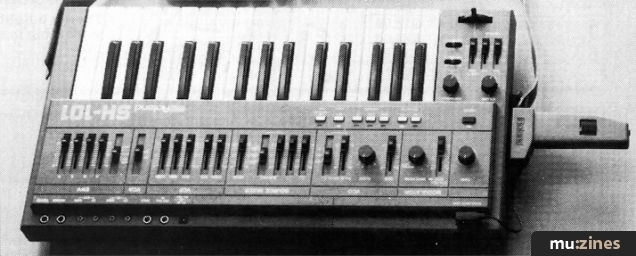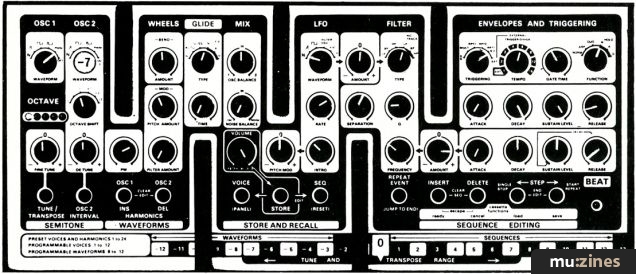Magazine Archive
Home -> Magazines -> Issues -> Articles in this issue -> View
Lead On | |
Article from Electronic Soundmaker & Computer Music, March 1984 | |
Follow-up to issue 1
Another look at monophonic synthesizers from the buyer's point of view.
In the very first issue of ES&CM we looked at lead-line or monophonic synthesizers, and the positive response to the article was so great that we thought it would be worth taking another look. This month's article cleans up a few of the models we didn't mention, and also keeps one eye on the second-hand market, which is very active at the moment with the price of polyphonics falling every day. Although the Moog Liberation featured here retails at almost £1,000, we start by examining a very inexpensive machine which can be picked up for around the £130 mark.
JEN SX-1000
The Jen SX-1000 is a low cost no-frills single oscillator monophonic. It is well made, has a pretty good sound (for a single oscillator job) and sells at a very low price.
The casework of this Italian made instrument is remarkably well formed and it provides the unit with an attractive housing that also affords it a considerable degree of protection. A music rack is provided, and this slots rather nicely into the rear panel.
The SX-1000 exclusively uses rotary controls — both switches and pots. This gives the instrument extremely clean lines, although settings of rotaries are somewhat less easy to see at a glance. The control knobs themselves are rather attractively color coded using metallicised caps.
The keyboard is adequate, however the main area of criticism must be directed towards the lack of any performance controls. To pitchbend a note, one has to use the tune control, and returning this to its original setting is no mean feat. Frequency modulation is more easily achieved by directly advancing the 'Vibrato' control, however this isn't to be found in the most convenient of locations.
The voltage controlled filter has a fairly uncoloured timbre to it, and it is nice to see that even on an instrument of such a low cost, it is possible to accommodate two ADSR envelopes, one for the filter, the other for the VCA.
Another rather unexpected bonus is the noise generator which can be set to produce either white or pink noise. Unfortunately the SX-1000 has no ports on the rear panel, so it is not possible to expand the system using sequencers and rhythm units.
Jen are keen to promote the SX-1000 as a beginners' synth, and as such it is a sound investment. As an aid to using the SX-1000, Jen include with the instrument a set of patch setting overlays. These are card sheets that sit over the control panel, and indicate how each control should be positioned in order to produce the specified voicing. This, is a particularly good idea, and one which might particularly suit the younger player.
Features:
1 x VCO; Noise (white/pink); 1 x VCF (LP); 2 x ADSR EGs; 1 x VCA; 1 x LFO
Keyboard — 3 octave C to C
Performance controls — none

Korg MS-10
The Korg MS-10 and Korg MS-20 are two of the most successful products in the field of mono synths. Both have been around for some five years now, and continue to be an ideal entree into the world of synthesizers. The reason they have remained so popular is that they are both inexpensive yet extremely versatile. Korg have achieved this unlikely combination by putting a jack field on the front control panel which enables the user to access the audio signal at several different stages in its travels, and also to process and re-route the control voltages as desired — so in a way, the MS-10 can be considered to be a very basic form of modular synthesizer.
The MS-10 has but one voltage controlled oscillator, though its sound is enhanced by means of pulse width modulation. The filter is a simple voltage controlled low pass job, with a rather nasal yet shrill character, which strangely, has helped it to retain its popularity over the years, as now this sound is more contemporary, and desirable.
One negative aspect of the MS series of synths lies in the fact that the voltage control system the units employ are linear — i.e. Hz/volt as opposed to the far more common octave/volt relationship — thus Korg's MS products aren't always directly interfaceable with other synths/sequencers.
The keyboard has a rather plasticky feel to it, but it must be remembered that this is a low cost product. On the performance control panel to the left of the keyboard is a wheel (with a rather weak centre detent) and a button, both of which can be routed to control various elements of the sound using the patch board.
Again the MS-10 is an ideal beginners' synth which can be expanded to form part of a larger system. Some may not like the lack of timbral depth, although in this case a chorus unit hooked on to the output works wonders.
Features:
1 x VCO; Noise; 1 x VCF (LP); 1 x ADSR EG; 1 x VCA; 1 X LFO.
Keyboard: 2½ octaves F to C
Performance controls: 1 x wheel.
Price: £289

Korg MS-20
The MS-20 is styled along similar lines to the MS-10, with a simple upright black plastic/metal casing and control and patch panel facilities. True, the styling of the MS range isn't particularly attractive but the design is ergonomically practical, especially if the synthesizer is to sit on top of a larger keyboard rig. But, the layout and graphics on the front panel may seem a little confusing and unclear at first.
This instrument is considerably more comprehensive than its small brother, with many more access points in the signal path available from the patch panel and more voice module circuits. It is true to say that for every extra facility, the power and versatility of an instrument is increased enormously.
There are two voltage controlled oscillators both providing a wide range of waveforms, and the sound generating power is further increased by virtue of the ring modulation facility, and the inclusion of both pink and white noise sources. As another bonus the filter section incorporates two separate voltage controlled elements — a low pass and a high pass filter, which further contributes to the versatility of the MS20.
The overall timbre of this synthesizer is, like the MS-10, rather on the harsh side, however this instrument is undeniably one of the most adaptable and flexible synthesizers ever produced, and is a sound investment for anyone wanting to get deeply involved in electronic music. There is a price to pay for this instruments' versatility and that relates to the difficulty in using the MS-20 in live situations. With so many variables, it isn't practical to start setting up different sounds on stage — the MS-20 is therefore best suited to the studio environment.
Features:
2 x VCO; Noise; 1 x VCF (LP) and 1 x VCF (HP); 1 x HADSR EG; 1 x DAR EG; 1 x VCA; 1 x LFO.
Keyboard: 3 octaves C to C
Performance controls: 1 x wheel
Price: £469

Korg Mono/Poly
Originally Korg wanted to do away with the oblique (/), but Waddingtons already had the monopoly on that name. And as one might suppose from the instrument's I.D. this is a monophonic synthesizer with polyphonic capabilities.
The idea behind the Mono/Poly centres around the oscillator bank which consists of four identical voltage controllable elements, each with separate waveform selectors, level, and pitch controls. The rest of the instrument is more traditionally monophonic with low pass VCF, two envelope generators and a VCA. There are four keyboard assign modes that determine how this instrument behaves. 'Unison' assigns all four oscillators to the note being played on the keyboard, whilst 'Chord Memory' allows the player to set up intervals between the various oscillators so although the keyboard is still operating in a monophonic mode, the oscillators aren't all producing notes of the same pitch. 'Poly' mode allows the user to play up to four notes and one oscillator is assigned to each note, whereas 'Unison/Share' assigns as many oscillators as are free to the notes being played, i.e. if just one note is played it is assigned all four oscillators, whilst holding two notes splits things up with two oscillators per note etc.
The poly modes are not polyphonic in the true sense of the word, because the output from all the oscillators are mixed together and the signal treated as a monophonic source for the remaining timbral and amplitude processing, however this is still a worthwhile facility to offer.
The Mono/Poly has several other interesting features that help to make it a highly desirable product. There is a polyphonic portamento facility, which can produce particularly dramatic sounds for a monophonic; cross modulation and synchronisation effects can be introduced between alternate oscillators, and a comprehensive arpeggiator will automatically memorise and replay patterns in various ranges and modes by simply holding the keyboard.
The Mono/Poly is best suited to the studio environment, where, in monophonic mode it is a knock-out. With four independent oscillators it can almost be considered as a small modular system. So for someone with a small home studio and with only enough money to invest in a single keyboard the Mono/Poly is the obvious answer.
Features:
4 x VCOs; Noise; 1 x VCF (LP); 2 x ADSR EGs; 1 x VCA; 2 x LFOs; Arpeggiator
Keyboard: 3½ octaves, F to C
Performance controls: 2 x wheels
Price: £695

Moog Rogue
In an attempt to produce a monophonic at even less cost than their extremely successful Prodigy, Moog launched the Rogue, which is a dual oscillator no-frills synth with a 2½ octave F to C keyboard. One of the main ways in which they managed to cut costs was by taking out the power supply and transformers from inside the chasis, and to use an external mains transformer. This has the advantage of making the unit smaller, lighter, and easier to produce.
The keyboard itself is as small as is practical for a monophonic synth — 2 octaves is too small a span. The keyboard is rather plasticky, and in fact the whole instrument doesn't feel as solidly constructed as most of Moog's earlier products, however it has to be remembered that this instrument is designed to a price.
The two performance control wheels are set into the main control panel, thus enabling Moog to make the instrument yet smaller, and to tie these controls more cleanly into the main circuit card.
The voice circuitry is nicely laid out, and although there are relatively few controls, the Rogue is a remarkably versatile character, with a surprisingly powerful sound which is not in keeping with the more traditional mellow smooth Moog timbre, it's brighter and perhaps a little harsher.
The Rogue is an ideal first time purchase, but, with its interface ports on the rear panel, it can form part of a larger and quite professional electronic music system package.
Features:
2 x VCOs; 1 x VCA (LP); 1 x ADSR EG; Gate EG; 1 x VCA, 1 x LFO Keyboard: 2½ octave F to C
Performance controls: 2 x wheels
Price: £289

Moog Liberation
The Liberation is rather an odd fish in the synthesizer world — it is often referred to as a mobile synthesizer as it comes in two sections, one of which contains the voice production circuitry and power supply etc, and the other which is the controller which consists of a keyboard and control panel shaped and worn rather like a guitar, and which will therefore allow the player to move around on stage without being rooted to a bank of keyboards.
Moog have designed the aptly named Liberation to perform a variety of roles — thus it is more than just a simple monophonic synthesizer, although, in order to keep costs down to a respectable level, it isn't really a polyphonic synth.
The controller consists of a 3½ octave force sensitive keyboard which is used to drive the synthesizer voice module, however in addition a polyphonic capability has been included in the form of a simple keyed Poly circuit which operates in a similar manner to an electronic organ. A tone generator produces a complete set of pitches for each note and these are simply gated by the keyboard switched — i.e. there's no polyphonic envelope shaping. Nevertheless, this is a useful facility to have especially as these polyphonic sounds can be modified using the mono-synth circuitry.
All the controls are to be found on the 14lb mobile unit which is linked to the static station by means of a 40' multiway cable. Audio and control interface outputs are taken from this power unit so there is just the single link cable to worry about.
Performance controls are located in the 'neck' of the Liberation and these are ergonomically designed to realise the 'feel' of the guitar, i.e. spring loaded edge wheel is used to bend the notes played, and this requires a similar action to that employed by a guitarist when bending a string. Also to be found in the neck are modulation and glide controls as well as a touch strip, which is an alternative pitch bend mechanism. The force sensitive keyboard is also used to provide modulation and accentuation effects and as a bonus it can be set to pull the synchronised oscillators apart for those feedback guitar simulations; so Moog have certainly given the Liberation as many expressive facilities as possible.
Unfortunately the Liberation has limited appeal. Recording musicians have no use for a mobile synthesizer, and it is possible to find instruments that can do as much for less money, so really the Liberation is only popular for those rock artists who don't want to be left out stuck behind a keyboard rig and want to pose with the rest of the band.
Features:
2 x VCOs; Square wave Poly Oscillators; Noise; 1 x VCF (LP); 2 x ADS EGs; 1 x VCA; 1 x LFO.
Keyboard: 3½ octaves F to C force sensitive
Performance controls: 3 x edge wheels; touch strip; keyboard
Price: £1141
Octave-Plateau Cat SRM II
The original Cat was based very closely on the ARP Odyssey, and in fact it is understood that there was certain legal action taken by ARP against Octave Electronics Inc. It seems that everything was cleared up, and now the third generation instrument (after the Cat, and Cat SRM) is available.
This is a very nicely made dual oscillator monophonic, with a three octave keyboard. The "SRM" in its name refers to the ability of the instrument's digital keyboard circuitry to store the values of both the lowest and highest notes played, thus the Cat SRM II can be used in a limited duophonic mode.
This synthesizer is remarkably versatile, and a great deal of thought has gone into providing as many cross modulation paths as possible between the various circuit elements. For example both oscillators and the filter can be individually modulated by the LFO, either envelope generator, or the other oscillator(s) in fully variable amounts. There are even two separate syncing modes.
The weakest element of the Cat SRM is most certainly the performance control section, situated above the left hand end of the keyboard. The pitchbender is a basic slide control fitted with a centre-detent (and a weak one at that). This is a very poor control however the situation can in part be resolved by connecting a "Catstick" which is a joystick controller for imparting much greater expressive control.
The rear panel of the Cat SRM II is most comprehensive with two audio outputs, and one input: filter, oscillator and pitchbend control pedal input ports; CV and Gate Ins and Outs; and a digital keyboard output providing serial data for processing by such external devices as computers, or other polyphonic peripherals.
The Cat SRM II isn't widely promoted in the UK, and the secondhand market is less than buoyant, which is a pity as there is a lot to be discovered in this relatively low cost monophonic.
Features:
2 x VCO; Noise; 1 x VCF(LP); 1 x ADSR EG; 1 x AR EG; 1 x VCA; 1 x LFO.
Keyboard: 3 octaves C to C duophonic
Performance controls: 1 x pitchbend slider (Catstick optional extra).
Octave-Plateau Kitten II
Similarly to the way in which the Cat was designed along the same lines as the ARP Odyssey, so the Kitten II owed a lot to the ARP Axxe. The second generation Kitten is a single oscillator monophonic styled in a similar fashion to its elder relative.
The Kitten II again uses digital keyboard encoding, but with just the single voltage controlled oscillator, there is no high note/low note duophony. Nevertheless, this basic monophonic has a lot to offer, especially to the first time buyer.
The single VCO produces pulse (width variable), sawtooth, and ramp waveforms and in addition there are two sub octave signals — one and two octaves down! These five waveform outputs each have their own level slider so it is possible to construct more complex shapes by combining these signals in differing amounts — note though that all these signals will be phase related.
Considerable thought has gone into the control voltage routings, and again there is considerable scope for all forms of periodic and aperiodic modulation.
The filter is a standard 24dB/octave low pass variety, which can be made to oscillate and to track the keyboard. Its timbral characteristics are on the bright rather than mellow side, and this makes the Kitten II a good imitative tool.
To help provide additional flexibility, the gate envelope can be used as an alternative to the ADSR contour for amplitude modulation.
Unfortunately, the Kitten II also suffers from a rather feeble performance control section, but like the Cat it too will accept the Catstick, if one feels that such an investment is warranted.
Roland SH-2
Although no longer in production, the SH-2 continues to be a popular dual oscillator synthesizer, as illustrated by the healthy second hand market. This is a compact and well designed machine, that offers a wide range of useful control facilities all presented in a sturdy and practical case.
This dual oscillator monophonic is driven by a three octave F to E keyboard. The F-scale keyboard is not very popular with current contemporary musicians, however the more jazz orientated players seem to prefer this scaling.
The waveforms produced by the oscillators include sine, sawtooth, square, and pulse (for VCO-1) and sawtooth, square and pulse (for VCO-2). It is useful to have a sine wave generated by at least one of the oscillators as filter derived sine waves are inherently out of tune, and also it is often advantageous to have a pure fundamental on which to add free phase harmonics from a second oscillator.
The SH-2's filter is rather the weak link of the unit as it does introduce a slightly mushy colouration to the overall sound, which some players may find a little disconcerting, but otherwise the synth is capable of producing a good variety of both imitative and abstract sounds.
The performance control is the usual Roland sprung return bender lever, which can be used to frequency shift both VCOs or, if desired, just VCO-2. It can also be used for filter articulation, however there is no means of introducing any form of LFO modulation with this control — vibrato, trill, or sample and hold modulation have to be introduced using the 'Mod' slider on the main panel. 'Auto Bend' is also to be found at this point, and this is a most useful effect that introduces an envelope controlled frequency modulation for auto-glide and similar applications.
The SH-2 does provide a complete set of interface ports, with even an audio input for filter modulation of external sources, however, there is no threshold detector for triggering the envelopes by this external signal.
This is a good workhorse synth, that isn't too flashy, or difficult to use. It could be used for both live and studio roles, and there is no doubt that it deserves its long lived popularity.
Features:
2 x VCO: 1 x VCF (LP); 1 x ADSR EG; 1 x Gate EG; 1 x LFO.
Keyboard: 3 octaves F to E.
Performance controls: 1 x bender
Price: £549
SCI Pro-One
The Pro-One was designed to be a low cost monophonic version of Sequential Circuits Inc's extremely successful Prophet 5 polyphonic; and to that end it can be seen that the design of its voice module is virtually identical to that of one of the Prophet's voices.
In order to keep costs down to a realistic level, SCI haven't used the same smart switches and attractive casework that gave the Prophet its distinctive air, instead the Pro-One has a most perfunctory appearance, nevertheless, as a monophonic it is brilliantly designed, and offers the user a wealth of timbral and control possibilities.
There are two non-programmable voltage controlled oscillators. VCO1 produces ramp and pulse (variable) waves, and VCO2 ramp, pulse and triangle. The fiter is a clean uncoloured job, with the usual 24dB/octave low pass characteristics, and there are two ADSR envelope generators.
The Pro-One has several exciting features one of which is most definitely the modulation section. This is an extremely complex array of controls, but it offers one considerable flexibility in signal routing. It may take the user some time to master this section, but having done so he will appreciate the possibilities this facility offers, with signal sources from the LFO, VCO-2, and the filter envelope controlling combinations from VCO-1 Freq, VCO-1 PW, VCO-2 Freq, VCO-2 PW, and Filter Freq either directly or via the performance control wheel.
Many synthesizers offer an external audio input socket for processing other sounds, few provide the facility of a threshold detector that can generate a trigger pulse from the incoming signal to fire the envelope generators.
The Pro-One is equipped with a sequencer (total storage space 40 equal time notes) and an arpeggiator, which will take the notes held and generate three different patterns using them.
Again the Pro-One scores heavily on its interfaceability, with CV and Gate ins and outs, and the aforementioned audio in. The Gate input doubles as a Clock input for syncing up the sequencer/arpeggiator, whilst the audio output provides enough signal to drive a pair of stereo headphones, although it would have been far better had SCI incorporated a separate jack.
For those wanting the imitative and abstract capabilities that typified the Prophet 5 in monophonic form then the Pro-One is the answer. The instrument has recently undergone a fairly substantial price reduction making it even more financially attractive. A quality product.
Features:
2 x VCOs; Noise; 1 x VCF (LP); 2 x ADSR EGs; 1 x VCA; 1 x LFO; Arpeggiator; Sequencer (2 sequences, 40 step notes total)
Keyboard: 3 octaves C to C
Performance controls: 2 x wheels
Price: £475
Teisco/Kawai S-60P
The S-60P is a single oscillator preset monophonic, which evolved from the success of the S-100P. Being a preset synthesizer, its applications are automatically defined, and is generally used in an imitative role, i.e. to simulate other instruments, and is often found atop a piano or organ. As all the sounds are preset, it is very quick and easy to use, and ideal for live performances.
The S-60P incorporates all the usual preset voicings from Trombone to Flute, Vibraphone to Violin. Undoubtedly the S-60P scores highest marks for its Whistle and Voice presets — sounds in which, for some reason, Teisco/Kawai excel (perhaps they use Tomita to programme their voicings).
Although these voicings are preset at the factory, it is possible to modify them somewhat, by adjusting the 'Brilliance' control, which varies the filter cut off frequency, and the 'Sustain'. The S-60P doesn't have any distinct performance control elements, instead the three octave keyboard is touch sensitive (pressure) and this can be used to introduce Wow/Wow (LFO modulation of the filter), Vibrato, and/or pitchbend — up or down.
The S-60P is a lovely little preset synthesizer, which again is rather on the pricey side, but the accuracy of the voicings and the ease with which the instrument can be controlled make it a joy to use.
Features:
16 presets
Keyboard: 3 octaves C to C pressure sensitive
Performance controls: pressure keyboard
Price: £450

Teisco/Kawai S-100P
To many, this is the Rolls Royce of the preset synthesizers. This was the very first synthesizer manufactured by Kawai, before they set up the Teisco division (which has now reverted back to using the Kawai name). The S-100P is designed as an organ top. This can be seen by the way in which the voicing selectors have been positioned below the keyboard, but of course it can be used as a solo synth in its own right.
There are 32 different preset voices selected by means of 17 colour coded switches — each switch when 'on' activates two presets, with a second master switch deciding which of the two should sound. The presets range from Tubas and Bassoons at 64', to Glockenspiels at 2', with a host of superb other voicings in between. Particularly effective are the Trumpet 16', Wood Bass 64', Violin (a solo) 8', and of course the Whistle 4', and Voice 16'. In addition to the orchestral presets, the S-100P has several 'Synthe Sound' voicings and Wave and Wind effects also.
The keyboard is touch sensitive, and can be used to introduce Growl, Vibrato, Wow, Brilliance, and pitchbend (up or down), whilst the presets can be further modified by statically amending their brilliance and envelope sustain characteristics.
The S-100P is also equipped with a Flanger and a Reverb unit, which further enhance an already pretty spectacular product. The keyboard is a joy to play, and the Kawai designers have certainly got the sounds right. The S-100P is undoubtedly the most professional of the preset monophonics and worth the rather high price tag it bears.
Features:
32 Presets; Flanger; Reverb
Keyboard: 3 octave C to C pressure sensitive
Performance controls: pressure keyboard
Price: £640

Yamaha CS-15D
The CS-15D from Yamaha is another extremely nice monophonic which many players tend to overlook because of the 'preset' tag. The main control panel does look rather cluttered for this kind of instrument, however, the CS-15D is very easy and efficient to use.
In keeping with some of Yamaha's larger synthesizers, this one utilises a dual channel system of operation. That is to say, every time a note is played, two separate tone generating voices are triggered. Channel 1 offers 15 preset voicings whilst Channel 2 features 14 more — all different. The fifteenth slot on Channel 2 is taken by the 'Manual' button, which allows the player to build up his own sounds using the fully variable controls located on the left of the main control panel. Here we have a VCO, Noise generator, VCF controls, and two sets of ADSR envelope sliders — so just the manual synth section is pretty impressive on its own.
The beauty of having two separate channels is that one can either select exactly the solo preset one requires, or layer the two channels on top of one another to provide exactly the desired effect e.g. a percussive xylophone note could be backed up with a string note. Alternatively it is possible to layer two similar sounds, e.g. violin and strings, and to detune one channel slightly to produce a rich free phase beating effect.
The CS-15D features a very nice three octave keyboard, and Yamaha have decided to give this instrument performance control wheels, although the centre-dente of the pitch bender is rather weak.
Separate outputs for each channel can be employed to give a more dramatic effect, but the CS-15D will perform just as well in monoaurality. In addition control voltage and trigger input and output ports are provided for both channels.
This is another example of fine design and intelligent combination of preset and variable elements. The CS-15D certainly deserves to be rated with the best of them.
Features:
2 x VCOs; Noise; 2 x VCF (LP/BP); 4 x ADSR EGs; 1 x VCA; 1 x LFO
Keyboard: 3 octaves C to C
Performance controls: 2 x performance wheels
Price: £739
More with this topic
Analogue Lives! - The Enduring Appeal Of Classic Synths |
History By Numbers - A Re-Review Of The Roland MC4 Microcomposer |
The Games People Played - YESTERYEAR'S GEAR: Olympic drums |
Grafton Vintage Sax - Alto Saxophone |
Alternative Analogue - Korg MS20 |
The Time Machine |
Sampling A Vintage |
The Moog Story - Keyboards |
Hands On: Moog MiniMoog |
Hands On: Roland TR808 Drum Machine |
80 Days - Yamaha CS80 |
Juno Jive! - Yesteryear's Gear: Roland Juno synths |
Browse by Topic:
Vintage Instruments
Also featuring gear in this article
Alternative Analogue - Korg MS20
(MT Jun 89)
How They Do Only You
(12T Nov 82)
Jen SX1000 Synthetone
(EMM Sep 82)
Korg Mono/Poly
(EMM Apr 82)
Korg MS10
(12T Dec 83)
Mono Mania - SEQUENTIAL CIRCUITS PRO ONE
(MT Oct 90)
Moog Rogue - Twin oscillator mono synth
(12T Nov 82)

Moog Rogue
(12T Dec 83)
Moog Source and Moog Rogue
(EMM May 82)
Patches
(PL Jan 81)
Playing The Game - Korg Mono/Poly
(MT Nov 88)
Pro-1 Micro Sequencing
(ES Apr 84)
Sequential Circuits Pro-One
(EMM Mar 82)
Sequential Circuits Pro-One
(12T Dec 83)
Teisco 60P - Preset mono synth
(12T Nov 82)
UC-1 Sequencer - Add-on unit for SCI Pro-One
(EMM Nov 83)
Patchwork
(EMM Apr 84)
Patchwork
(EMM May 84)
Patchwork
(EMM Sep 84)
Patchwork
(EMM Oct 84)
Patchwork
(EMM Jan 85)
Patchwork
(EMM Mar 86)
Patchwork
(MT Nov 86)
Patchwork
(MT Dec 86)
Patchwork
(MT Mar 87)
Patchwork
(MT Apr 87)
Patchwork
(MT Feb 88)
Patchwork
(MT May 88)
Patchwork
(MT Oct 88)
Patchwork
(MT Dec 88)
...and 13 more Patchwork articles... (Show these)
Browse category: Synthesizer > Jen
Browse category: Synthesizer > Korg
Browse category: Synthesizer > Moog
Browse category: Synthesizer > Octave-Plateau
Browse category: Synthesizer > Roland
Browse category: Synthesizer > Sequential Circuits
Browse category: Synthesizer > Teisco
Browse category: Synthesizer > Yamaha
Publisher: Electronic Soundmaker & Computer Music - Cover Publications Ltd, Northern & Shell Ltd.
The current copyright owner/s of this content may differ from the originally published copyright notice.
More details on copyright ownership...
Topic:
Vintage Instruments
Gear in this article:
Synthesizer > Jen > SX-1000
Synthesizer > Korg > MS10
Synthesizer > Korg > MS20
Synthesizer > Korg > Mono/Poly
Synthesizer > Moog > Rogue
Synthesizer > Moog > Liberation
Synthesizer > Octave-Plateau > Cat SRM II
Synthesizer > Octave-Plateau > Kitten II
Synthesizer > Roland > SH-2
Synthesizer > Sequential Circuits > Pro 1
Synthesizer > Teisco > S-60P
Synthesizer > Teisco > S-100P
Synthesizer > Yamaha > CS-15D
Gear Tags:
Feature
Help Support The Things You Love
mu:zines is the result of thousands of hours of effort, and will require many thousands more going forward to reach our goals of getting all this content online.
If you value this resource, you can support this project - it really helps!
Donations for April 2024
Issues donated this month: 0
New issues that have been donated or scanned for us this month.
Funds donated this month: £7.00
All donations and support are gratefully appreciated - thank you.
Magazines Needed - Can You Help?
Do you have any of these magazine issues?
If so, and you can donate, lend or scan them to help complete our archive, please get in touch via the Contribute page - thanks!


